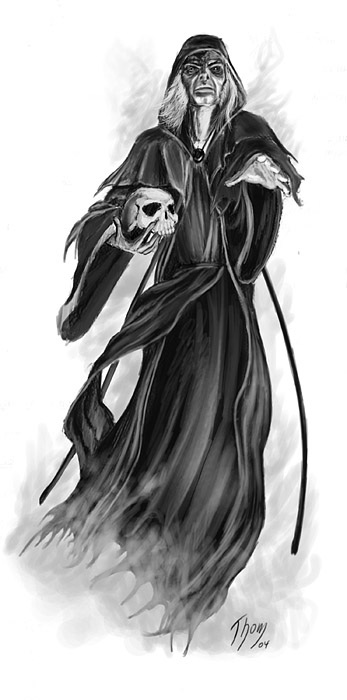Elf, Dwarf, Gnome, Halfling. Since the first edition of D&D players have had a wide variety of fantasy races to choose from when creating their characters. With 4e D&D the list of races is quite extensive and it continues to expand with every new version of the Players Handbook and with every monthly update of the character builder. The worlds of D&D are full of tolerant people willing to accept everyone based on deeds rather than their race. No matter what race your PC happens to be, he’s usually accepted as a hero and welcomed into villages, towns and cities. An adventuring party that consists of a Dragonborn, a Drow, a Half-Elf, a Tiefling, a Half-Orc and a Gnome doesn’t draw attention, ridicule or suspicion as they enter a tavern for the first time. We don’t question it; we just accept that this is how things work when you’re playing D&D.
Tag: Dungeons and Dragons
Never split the party. The very tagline of 4e D&D implies that adventures should revolve around an entire party and not one lone hero. But that doesn’t mean that an adventure can’t revolve around a party of one.
In this article we continue with our look at how to run a game for just one PC. In D&D Party of One (Part 1) we explored the ups and downs of combat encounters during solo games. Today we’re going to look at skill challenges and the unique role-play opportunities that solo gaming presents. In D&D Party of One (Part 3) we’ll be focusing on the solo game from the PC’s perspective.
The Necromancer

Necromancy, the study of the Black Arts.
Necromancers study death in a way that few other mortals would contemplate. Motivated by power, knowledge, greed or life eternal, these individuals will stop at nothing in their search for the understanding of life and the secrets it holds.
Our exploration of the Necromancer in 4e D&D continues at Dungeon’s Master. We’re expanding on our initial Necromancer articles and focusing on the motivation behind this often misunderstood class. In our previous examination of the Necromancer we provided powers and resources that you could use in your regular games.
Revised
We’ve recently undertaken the process of updating these articles to balance the powers.
- Necromancer: Heroic Tier (Revised)
- Necromancer: Paragon Path (Revised)
- Necromancer: Epic Tier (Revised)
Over the past few weeks we’ve noticed increased activity on these pages and as we enter into October and Halloween draws nearer, this article on the Necromancer is the first of several articles that will discuss the undead and their place in Dungeons & Dragons.
Top 10 of the Past 200
Dungeon’s Master was launched in February and since then we’ve published a lot of content that we are really proud of. Today marks our 200th post and to celebrate we’re sharing the top 10 posts of the past eight months with our readers. It was an interesting exercise examining the information provided by Google Analytics and I can honestly say I’m surprised by the results. While I expected some articles to be in the top 10, I didn’t anticpate the order in which they would appear.
I’d like to thank you our readers for visiting the site, and for providing your comments and insight on the game that we all love. So here they are, the top 10 posts as selected by you, our readers.
When was the last time you played D&D and it was just one PC and one DM? I’d be amazed if anyone can say that they’ve done this since the release of 4e D&D. The changes that accompanied 4e make solo gaming almost too difficult to be practical. That’s not to say that it’s impossible, but it’s a lot more work for a DM to create and run a game with just one player in 4e then it ever was in previous editions.
Some of the most memorable and enjoyable games of D&D I ever played had only one player. It’s an entirely different way to experience D&D regardless of which side of the screen you’re on. As much as I like 4e and as much as I believe it’s a vastly improved system over its predecessors, these improvements have come with some sacrifices. One of those sacrifices is the feasibility of the one player game.
Month in Review: September 2009
September was a big month for D&D with the release of the DMG2. Keeping that in mind, we ran a lot of articles geared towards the DM last month. But that didn’t mean that we forgot about the players entirely. As usual we try to provide a good balance between DM and player resources. We also provided two new skill challenges, a couple of book reviews, some Eberron-specific materials and of course our opinion on a number of D&D related topics. September was another great month at Dungeon’s Master and as we so often do we want to thank you, the readers, for visiting us every day. If you’re new to Dungeon’s Master then you might have missed some of the great articles we ran throughout September. Here are the highlights.
 As the DM you have an important role. You control the action, pacing, drama, intrigue and excitement that exists during your gaming sessions. This role is an important responsibility, that if misused will result in player defections, absences or the demise of your group. Time spent between gaming sessions becomes critical regarding your preparation. Nothing is more disappointing to a PC than to arrive for the weekly gaming session and discovering that the DM isn’t ready.
As the DM you have an important role. You control the action, pacing, drama, intrigue and excitement that exists during your gaming sessions. This role is an important responsibility, that if misused will result in player defections, absences or the demise of your group. Time spent between gaming sessions becomes critical regarding your preparation. Nothing is more disappointing to a PC than to arrive for the weekly gaming session and discovering that the DM isn’t ready.
The PCs are about to face the most dangerous threat of their adventuring careers… kids.
Setup
The PCs need a favour from an innkeeper, merchant or noble figure. The cost of the favour is babysitting. This might be only for a few hours but it could be as long as a few days (this is left up to the DM). Fighting monsters is easy compared to watching young children. Can the PCs entertain and feed the children without getting them killed?
Review: Word of Traitors

Word of Traitors
(Legacy of Dhakaan, Book II)
Don Bassingthwaite
An Eberron Novel
Word of Traitors is without a doubt the best Eberron novel to date. It’s book two of the Legacy of Dhakaan trilogy. If you haven’t already read The Doom of Kings, book one in the Legacy of Dhakaan trilogy then be forewarned that this review will contain spoilers.
I Wish for a Wish Spell in 4e D&D
In previous editions of D&D you knew that your PC reached the pinnacle of power when he could cast the wish spell. Wish always represented the most powerful and complicated spell in the PHB no matter which version of D&D you were playing. As if to make wish even more desirable, there existed limited wish – a spell that’s only purpose was to give you a diluted taste of the real thing. Now we have 4e D&D and I can’t find wish anywhere. What happened to the wish spell?